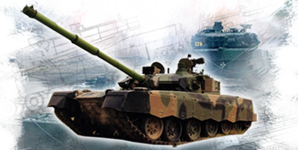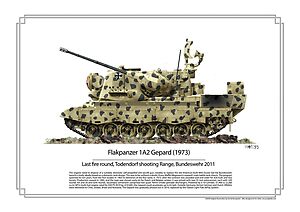The Al-Hussein was a Jordanian Main Battle Tank, result of the donation of between 392 and 402 Challenger I main battle tanks that arrived to the end of their service from 1999 and until 2002. Apart a revamped air conditioning system, they were "stock". However it was soon attempted by King Abdullah II Design and Development Bureau (KADDB, now JODDB) to upgrade the park with a new gun, new FCS, and the Falcon unmanned turret, or to lead to a more austere modernization program. However nothing came of it after three prototypes. The Army decided to get rid of its Al-Husseins in 2018 for 80 UAE Leclerc MBTs and Centauro wheeled tanks as complement.

The Shir I MBT intended to Iran. They were shipped instead to Jordan
The latter had even stronger links with Britain, starting there his military career, a princ and officer cadet at Royal Military Academy Sandhurst and for a year as a troop commander in the 13th/18th Royal Hussars (British armoured cavalry regiment). As a member of the Royal Jordanian Army, he also was made a tank company commander. Abdullah wanted a career in the military, but on 24 January 1999, he replaced his uncle Hassan as heir apparent as his father fell badly ill.
In March 1999 after he ascended the British Government wanted to support Jordan's foreign policy, and followed a request announced an agreement to supply Jordan no less than 288 Challenger 1 tanks that were about to be replaced by the new Challenger 2. Aaverage book value was £750,000 still,but after retirement, they were supplied to Jordan at no cost when stricken from the register. In fact thay would have cost much to dismantle and recycle. The Jordanian Government agreed to cover all transfer costs and the deal even included 112 support vehicles, parts and training.

Jordanian Al-Khalid
This first batch came over a three-year period (1999-2002), enabling replacement of the Jordanian fleet of Centurions (locally "Tariq"). In late 2002, 114 more Challenger 1 and 19 training versions were also gifted, at a value of £385,000 per unit exchanged for the cost of transfer again. Henceforth, Jordan ended with an impressive fleet of 402 Jordanian Challenger 1, making by quality, not by number, one of the most impressive MBT park in the middle east. They were judged much superior to the current T-72 at the time, or even a match to the Israeli Merkava II.
But it was not all. These Challengers received substantial local modifications, at Jordan's expenses, until being acepted into service as the "Al-Hussein". Plans to upgrade these Jordanian Challengers were in fact quite extensive (that's the subject of this article) but also included a final phase that wa s the replacement of the standard turret by a brand new, locally designed unmanned turret called "Falcon", first presented to the press in 2003.

Prototypes were produced and tested. However, this new turret design never reached full production (see later) and by 2016 all the converted prototypes were shelved, refitted wit standard turrets. The Jordanian Challenger 1 fleet was active thus from 2002 to January 2023, so over 20 years, a good service, especially for second hand tanks. Replacement options were discussed such as French-made Leclercs from the UAE and/or ex-Italian Centauro wheeled tank destroyers. The Al-Hussin are now in storage. But after the 2022 Russian invasion of Ukraine they had been speculations about their refurbishment for Ukrainian use, so basically from a desert to a cold climate again. Sources diverged about the exact transfers, from 392 to 402. The most commonly accepted is the latter.
Compared to the Chieftain which had an excellent new gun and armour but was slow, the core spec. for the Challenger I was speed, and thus the hull was lightened up, the engine was pushed ahead making for a top Speed of c56 km/h (35 mph) on road, which was an improvement. Its operational Range was superior as well as 450 km (280 mi). Indeed the Chieftain was initially created for the BAOR (British Army of the Rhine) and distances to cross were moderate.
The Challenger I was armed with essentially the same, but improved 120 mm Royal Ordnance L11A5 rifled gun capable of firing APFSDS, HESH, and smoke rounds. It was seconded by a 7.62 mm coaxial L8A2 machine gun and 7.62 mm L37A2 machine gun on the commander's cupola. It was protected by a Chobham composite armor, enhanced compared to the Chieftain's (details still classified) but made of layered ceramic armor offering strong protection against both kinetic and shaped charge threats.
It was also, as all cold war tanks, fitted with NBC (Nuclear, Biological, Chemical) protection and had an automated fire suppression system. It entered Service in 1983 and had its fair share of action at the Gulf War (1991), playing a major role in Operation Granby (British part of Operation Desert Storm). It was known for excellent long-range gunnery and survivability and was replaced by the close Challenger 2 in British service from 1998 onward. The latter ware largely based on the improvements made on the Al-Hussein, which acted a bit as a prototype for this new series.
It was considered for example not useful to modernize the gun and ammunition and leave the old TOGS-based Fire Control System untouched. Both needed to be replaced and there was a lot of options on the market, with KADDB engineers settling on the Swiss RUAG CTG (Compact Tank Gun) 120mm L/50 smoothbore. Forom the start it was also envisioned to develop an entirely new low-profile turret for this gun paired with a new automatic loading mechanism and new Fire Control System. The secondary objective, was to upgrading existing vehicle's turret with the same new gun and FCS.
The first objective led to design the new FALCON turret, unveiled to the public in 2003, a radical departure over the Challenger 1. Due to this, the new automated pannier took a lot of space, and the now 2-man crew was moved further back into the hull, enhancing its safety like on IDF tanks, sandiwched between the turret pannier and engine. The turret was made extremely low with an extremely narrow face, but also reducing the silhouette overall. However it soon appeared as a massive overtaking for a small country like Jordan.
For hull and engine, performances details, see the Challenger I.
The Jordanian Falcon Turret was an indigenously developed turret system designed to modernize the Al-Hussein tanks in service with Jordan (known locally as). It represents a major upgrade to both firepower and fire control capabilities. It came from the newly funded King Abdullah II Design and Development Bureau (KADDB, now known as JODDB), originally designed to modernize Al-Hussein (Jordan’s Challenger 1) MBTs for the later 2020s. This was an unmanned, low-profile turret, prsending a very small target from the front, but it ever remained at prototype or at Concept stage as of last confirmed public info. Fully remotely operated, it had the advantage of reducing the crew's exposure to enemy fire, and was the first of the kind at the time, the Russian T14 Armata being anotger try at the concept, that actually saw production.
This allowed the crew to be moved entirely into the hull for greater protection while still using the very same 120 mm L11A5 smoothbore gun (NATO standard) Compatible with modern ammunition including APFSDS and programmable HE rounds. It used a classified advanced fire control system, albeit the prototype seemlingly used the same already deployd on the Al-Hussein. Meanig it had the same thermal sights, improved laser rangefinder, but it was suggested a possible auto-target tracking as well as day/night/all-weather combat capability. The 7.62 mm coaxial machine gun remained, but the turret was also optionally fitted with a mock Remote weapon station (RWS), or the hull.
However this turret was designed to be modular, allowing potential use on other tank platforms (e.g., M60, T-72), thanks to a scalable turret ring mount. This allowed to reduce the crew to 3 thans to its automatic loader, commander (which could also take on firing if needed), gunner below the turret, and driver at the same place in the tank. It showed part of Jordan’s effort to extend the life and combat capability of legacy Western MBTs but was ultimately not adopted probably due to technical shortcomings and cost. It was marketed too in some exhibitions but never sold.
Wether it was mounted on a Falcon, or in the original turret (which ended the case), this new gun adopted, massively increased firepower. The 120mm L/50 Swiss RUAG Defense Systems smoothbore cannon, was not rifled like the former gun, and thus aligned general ballistic performance to NATO smoothbore levels. Trials were performed in 2005 and it was already automatically loaded with a rate of fire at 8 rounds a minute. More interesting was the adoption of the park of modern standard smoothbore NATO 120mm ammunition. The new Falcon had an automatic fire suppression system and teh same NBC protection.
After the FALCON turret program never reached production stage and was stopped altogether, an improved version called FALCON 2 was later presented, the a FALCON 3 turret, but they remained paper projects. At least the Falcon I was mounted and trialled on a prototype, now preserved at the Royal Jordanian Tank Museum. The Jordanians decided for a cheaper, more auster approach to keep the Al-Hussein updated and replace the main gun with a RUAG CTG, but this time manually loaded. The FCS was the latest offer by Raytheon, identical to those sported by the upgraded Jordanian M60A3 tanks, featuring the same say/night sights with thermal optics, integrated laser rangefinder and weather sensors on mast, mounted on the turet's roof.
There was an option to miunt the CITV thermal imager at least shown as mock-up on a prototype for a proper hunter-killer mode. The new turret thus features an absence of TOGS sights to the right and the gun has a new electric control system, made locally by Raytech Jordan.
The turret armor was allegedly improved but details of the new armour are classified. Probably of the "improved Chobham" type featured by the Challenger II. Other changes inclides:
-Semi-automatic Claverham loading assistant (better rate of fire in the bustle)
-New AB8 engine auxiliary power unit (APU) for extra equipment's power when the vehicle is cold
-Upgraded NBC and much improved air-conditioning system in the hull, instead of the the turret bustle
These features were showcased on a prototype in 2004 called the "Al-Hussein Hybrid", followed by three more in 2005 and 2006, each with a different configuration and notably a mockup CITV on top of the gunner optics. However even this austere upgrade was not supported by the Jordanian military. Trials and negotiations dragged on until the army decided in 2018 to scrap the entire program and instead replace all its park of Al-Hussein tanks, settling eventually on second-hand Italian wheeled Centauro tank destroyers whereas Jordan in 2020 received 80 Leclerc MBT from the UAE.
Development
In the 1980s, Jordan became interested to purchase the original Shir 1 design for Iran, derived from the Challenger and already pioneering many aspects of the future Challenger I. Subsequently Jordan ordered 274 Khalid tanks, which success maintained Jordanian interest in British made tanks. The replacement of the Challenger 1 in British service in what became later the Challenger 2 matched the accession of Abdullah II as King of Jordan.
The Shir I MBT intended to Iran. They were shipped instead to Jordan
The latter had even stronger links with Britain, starting there his military career, a princ and officer cadet at Royal Military Academy Sandhurst and for a year as a troop commander in the 13th/18th Royal Hussars (British armoured cavalry regiment). As a member of the Royal Jordanian Army, he also was made a tank company commander. Abdullah wanted a career in the military, but on 24 January 1999, he replaced his uncle Hassan as heir apparent as his father fell badly ill.
In March 1999 after he ascended the British Government wanted to support Jordan's foreign policy, and followed a request announced an agreement to supply Jordan no less than 288 Challenger 1 tanks that were about to be replaced by the new Challenger 2. Aaverage book value was £750,000 still,but after retirement, they were supplied to Jordan at no cost when stricken from the register. In fact thay would have cost much to dismantle and recycle. The Jordanian Government agreed to cover all transfer costs and the deal even included 112 support vehicles, parts and training.

Jordanian Al-Khalid
This first batch came over a three-year period (1999-2002), enabling replacement of the Jordanian fleet of Centurions (locally "Tariq"). In late 2002, 114 more Challenger 1 and 19 training versions were also gifted, at a value of £385,000 per unit exchanged for the cost of transfer again. Henceforth, Jordan ended with an impressive fleet of 402 Jordanian Challenger 1, making by quality, not by number, one of the most impressive MBT park in the middle east. They were judged much superior to the current T-72 at the time, or even a match to the Israeli Merkava II.
But it was not all. These Challengers received substantial local modifications, at Jordan's expenses, until being acepted into service as the "Al-Hussein". Plans to upgrade these Jordanian Challengers were in fact quite extensive (that's the subject of this article) but also included a final phase that wa s the replacement of the standard turret by a brand new, locally designed unmanned turret called "Falcon", first presented to the press in 2003.

Prototypes were produced and tested. However, this new turret design never reached full production (see later) and by 2016 all the converted prototypes were shelved, refitted wit standard turrets. The Jordanian Challenger 1 fleet was active thus from 2002 to January 2023, so over 20 years, a good service, especially for second hand tanks. Replacement options were discussed such as French-made Leclercs from the UAE and/or ex-Italian Centauro wheeled tank destroyers. The Al-Hussin are now in storage. But after the 2022 Russian invasion of Ukraine they had been speculations about their refurbishment for Ukrainian use, so basically from a desert to a cold climate again. Sources diverged about the exact transfers, from 392 to 402. The most commonly accepted is the latter.
About the base: Challenger 1 Tank
The "chally 1" was a British main battle tank (MBT) of 3rd generation, which served with the British Army from the early 1980s until the late 1990s. It was developed as a successor to the Chieftain and was later replaced by the Challenger 2 but still is used by Jordan today as the heavily modified Al-Hussein. The Crew of 4 comprised the commander, gunner, loader, driver for an overall weight of 62 metric tons, powered by a Rolls-Royce CV12 TCA V12 diesel engine (1,200 hp).Compared to the Chieftain which had an excellent new gun and armour but was slow, the core spec. for the Challenger I was speed, and thus the hull was lightened up, the engine was pushed ahead making for a top Speed of c56 km/h (35 mph) on road, which was an improvement. Its operational Range was superior as well as 450 km (280 mi). Indeed the Chieftain was initially created for the BAOR (British Army of the Rhine) and distances to cross were moderate.
The Challenger I was armed with essentially the same, but improved 120 mm Royal Ordnance L11A5 rifled gun capable of firing APFSDS, HESH, and smoke rounds. It was seconded by a 7.62 mm coaxial L8A2 machine gun and 7.62 mm L37A2 machine gun on the commander's cupola. It was protected by a Chobham composite armor, enhanced compared to the Chieftain's (details still classified) but made of layered ceramic armor offering strong protection against both kinetic and shaped charge threats.
It was also, as all cold war tanks, fitted with NBC (Nuclear, Biological, Chemical) protection and had an automated fire suppression system. It entered Service in 1983 and had its fair share of action at the Gulf War (1991), playing a major role in Operation Granby (British part of Operation Desert Storm). It was known for excellent long-range gunnery and survivability and was replaced by the close Challenger 2 in British service from 1998 onward. The latter ware largely based on the improvements made on the Al-Hussein, which acted a bit as a prototype for this new series.
Design Differences
Al-Hussein was named after king Hussein of Jordan, successful ruler, father of the current Jordanian king Abdullah II. After the 2000s, the tank was considered obsolescent, being based on 1980s tech. Its 120mm 1-piece rifled gun was seen as an oddity, suffering from obsolete ammunition. To deal with the Israeli Merkava III-IV it was no longerr up to the task, and even if Jordan was no longer interested another "adventure" against Israel, the new King wanted still its MTBs to remain relevant. That's why the King Abdullah Design and Development Bureau (KADDB) was created for. It's objectives were simple.It was considered for example not useful to modernize the gun and ammunition and leave the old TOGS-based Fire Control System untouched. Both needed to be replaced and there was a lot of options on the market, with KADDB engineers settling on the Swiss RUAG CTG (Compact Tank Gun) 120mm L/50 smoothbore. Forom the start it was also envisioned to develop an entirely new low-profile turret for this gun paired with a new automatic loading mechanism and new Fire Control System. The secondary objective, was to upgrading existing vehicle's turret with the same new gun and FCS.
The first objective led to design the new FALCON turret, unveiled to the public in 2003, a radical departure over the Challenger 1. Due to this, the new automated pannier took a lot of space, and the now 2-man crew was moved further back into the hull, enhancing its safety like on IDF tanks, sandiwched between the turret pannier and engine. The turret was made extremely low with an extremely narrow face, but also reducing the silhouette overall. However it soon appeared as a massive overtaking for a small country like Jordan.
For hull and engine, performances details, see the Challenger I.
The Falcon Turret

The Jordanian Falcon Turret was an indigenously developed turret system designed to modernize the Al-Hussein tanks in service with Jordan (known locally as). It represents a major upgrade to both firepower and fire control capabilities. It came from the newly funded King Abdullah II Design and Development Bureau (KADDB, now known as JODDB), originally designed to modernize Al-Hussein (Jordan’s Challenger 1) MBTs for the later 2020s. This was an unmanned, low-profile turret, prsending a very small target from the front, but it ever remained at prototype or at Concept stage as of last confirmed public info. Fully remotely operated, it had the advantage of reducing the crew's exposure to enemy fire, and was the first of the kind at the time, the Russian T14 Armata being anotger try at the concept, that actually saw production.
This allowed the crew to be moved entirely into the hull for greater protection while still using the very same 120 mm L11A5 smoothbore gun (NATO standard) Compatible with modern ammunition including APFSDS and programmable HE rounds. It used a classified advanced fire control system, albeit the prototype seemlingly used the same already deployd on the Al-Hussein. Meanig it had the same thermal sights, improved laser rangefinder, but it was suggested a possible auto-target tracking as well as day/night/all-weather combat capability. The 7.62 mm coaxial machine gun remained, but the turret was also optionally fitted with a mock Remote weapon station (RWS), or the hull.
However this turret was designed to be modular, allowing potential use on other tank platforms (e.g., M60, T-72), thanks to a scalable turret ring mount. This allowed to reduce the crew to 3 thans to its automatic loader, commander (which could also take on firing if needed), gunner below the turret, and driver at the same place in the tank. It showed part of Jordan’s effort to extend the life and combat capability of legacy Western MBTs but was ultimately not adopted probably due to technical shortcomings and cost. It was marketed too in some exhibitions but never sold.
Austere Upgrades ?

Wether it was mounted on a Falcon, or in the original turret (which ended the case), this new gun adopted, massively increased firepower. The 120mm L/50 Swiss RUAG Defense Systems smoothbore cannon, was not rifled like the former gun, and thus aligned general ballistic performance to NATO smoothbore levels. Trials were performed in 2005 and it was already automatically loaded with a rate of fire at 8 rounds a minute. More interesting was the adoption of the park of modern standard smoothbore NATO 120mm ammunition. The new Falcon had an automatic fire suppression system and teh same NBC protection.
After the FALCON turret program never reached production stage and was stopped altogether, an improved version called FALCON 2 was later presented, the a FALCON 3 turret, but they remained paper projects. At least the Falcon I was mounted and trialled on a prototype, now preserved at the Royal Jordanian Tank Museum. The Jordanians decided for a cheaper, more auster approach to keep the Al-Hussein updated and replace the main gun with a RUAG CTG, but this time manually loaded. The FCS was the latest offer by Raytheon, identical to those sported by the upgraded Jordanian M60A3 tanks, featuring the same say/night sights with thermal optics, integrated laser rangefinder and weather sensors on mast, mounted on the turet's roof.
There was an option to miunt the CITV thermal imager at least shown as mock-up on a prototype for a proper hunter-killer mode. The new turret thus features an absence of TOGS sights to the right and the gun has a new electric control system, made locally by Raytech Jordan.
Other Upgrades

The turret armor was allegedly improved but details of the new armour are classified. Probably of the "improved Chobham" type featured by the Challenger II. Other changes inclides:
-Semi-automatic Claverham loading assistant (better rate of fire in the bustle)
-New AB8 engine auxiliary power unit (APU) for extra equipment's power when the vehicle is cold
-Upgraded NBC and much improved air-conditioning system in the hull, instead of the the turret bustle
These features were showcased on a prototype in 2004 called the "Al-Hussein Hybrid", followed by three more in 2005 and 2006, each with a different configuration and notably a mockup CITV on top of the gunner optics. However even this austere upgrade was not supported by the Jordanian military. Trials and negotiations dragged on until the army decided in 2018 to scrap the entire program and instead replace all its park of Al-Hussein tanks, settling eventually on second-hand Italian wheeled Centauro tank destroyers whereas Jordan in 2020 received 80 Leclerc MBT from the UAE.

Author's profile, early batch

Later batch
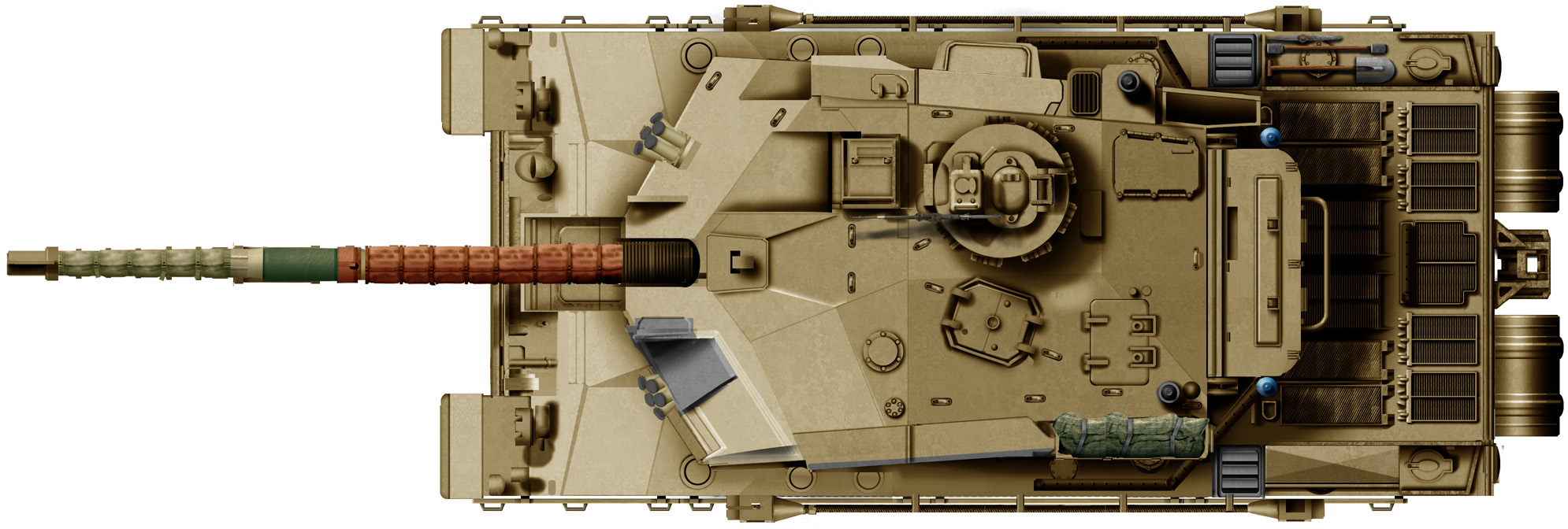
Top
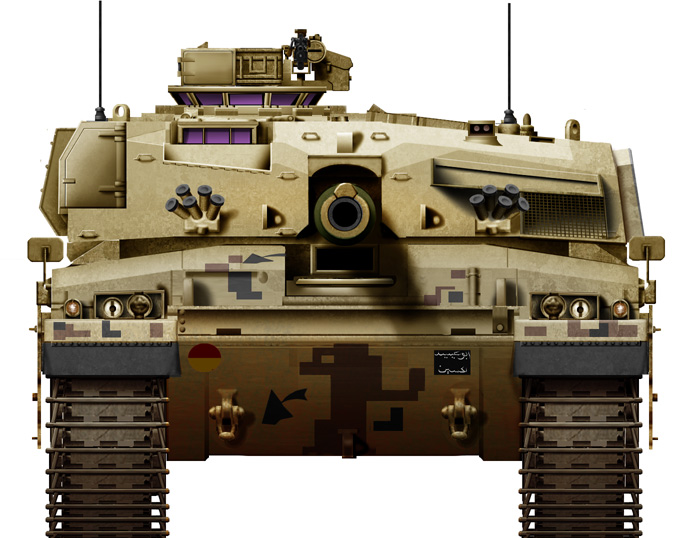
Front
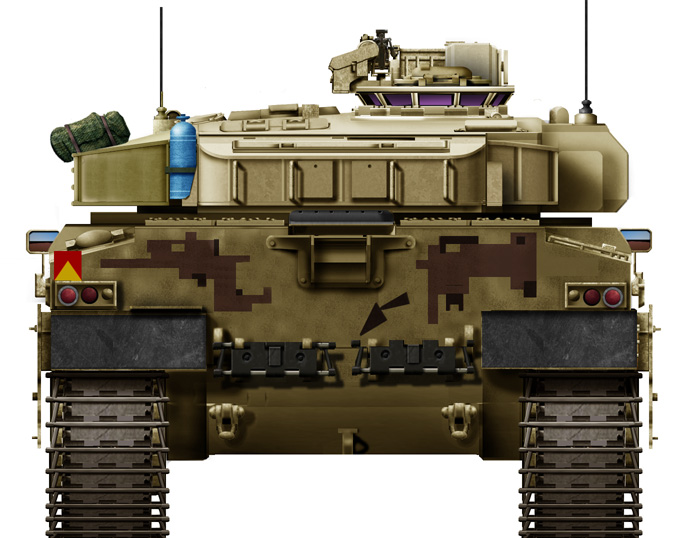
Back











Src
militaryperiscope.comdefence-blog.com Jordan received its first Leclec Tanks
defence.pk
armyrecognition.com Germany's refurbishement proposal for Ukraine
jaf.mil.jo
Jordanian Tank Museum (where the Al-Hussein belongs now)
facebook.com/
world-defense.com
military-today.com
armyrecognition.com
reddit.com

